
F1 at Love Falls
I’m often asked about the knife I carry. So I thought I’d share a little about it. My general purpose knife is the Fallkniven F1. Fallkniven is a Swedish company and embodies Scandinavia’s long tradition of knife making. The F1 has been the official survival knife of the Swedish Air Force since 1995. It is designed to be compact, lightweight, versatile and durable.
Facts and Figures
Here are some quick numbers on the F1. You can read more about its technical specifications by visiting the Fallkniven website for the F1 version I carry.
| Total length | 8.3 inches |
| Length of blade | 3.8 inches |
| Blade thickness | 0.18 inches |
| Tang | Full tang, hidden, protrudes at back |
| Weight | 5.3 ounces |
| Steel | Laminated VG-10 |
| Blade hardness | 59 HRC |
| Handle | Thermorun |
| Sheath | Zytel |
Thermorun is a hard, but grippy, rubber-thermoplastic combination. The handle wraps completely around the tang of the knife to insulate your hands from the steel in freezing weather. The handle has a slimmer profile so you can use the knife easily while wearing gloves. But some people with large hands complain that the handle is uncomfortably thin. It fits my medium-sized hands perfectly.
Zytel is a high strength thermoplastic. I discuss the steel below, in the section about detecting counterfeits.
My Impressions
Instead of the “standard” knife review, I would like to try something different. I’ve carried the F1 for years. So the following paragraphs represent a “stream of consciousness” based on my experience with the knife…
The primary application for my knife is wilderness survival. It is light and easy to carry so I always have it with me. It is reliable and tough. One very important feature of the F1 is that it has a full tang. This means that the steel of the blade extends through the handle. Since the blade and handle are one piece, it makes it virtually impossible to break the handle of the knife, even if you abuse it. The blade itself is relatively thick and I have never worried that I will harm it – even when I was just starting out. For a little over $100, I have a knife I trust implicitly.
| Important:
The F1 is amazingly sharp out of the box. But I suggest you strop the blade before using it for heavy work. I find that the factory edge is prone to develop small nicks if you do heavy work with it, like batoning. I stropped my new F1 (my second) before I first used it to baton. This gave me a more robust convex edge and I never experienced chips during hard use. |
The handle fits my small hands perfectly. It is easy to wield and feels like an extension of my arm. I have used my knife for the following activities:
-
- To baton and process wood for making fire and building shelters
- To carve bow-drill sets
- To harvest and process wild edible and medicinal plants
- For food preparation around camp
- To build traps and snares
The F1 excels at fire and shelter building. But it is a little weaker at the tasks that require fine carving. The thickness of the blade and the convex grind make it a bit trickier for me to control. As someone learning bushcraft skills, I have to work a little harder sometimes because of this. But I willingly accept the tradeoff because the knife excels at the survival tasks that are my primary application!
Use with a Firesteel
The F1 is specifically designed for use with a firesteel. The edges of the spine are squared 90-degrees. Scraping with the edge of the spine throws amazingly large sparks!
Not all knives are designed for use with a firesteel. For example, many models of the popular Mora knives have rounded spines. They slide along the firesteel without generating sparks. You should consider this when you select a bushcraft knife.
Here is a video of me using my F1 to light a cotton ball coated with petroleum jelly:
Sheath and Modifications
There are two sheaths available for this knife: Leather and zytel (a plastic). I like the zytel sheath. I do a lot of bushwacking and I often punish the sheath. I regularly bang it on rocks or wood when I sit down. But the sheath is tough and has withstood years of wear and tear. It is not fashionable. But it is very discreet and most people do not realize I am carrying a knife on my belt until I whip it out (my knife). 🙂
I have made two modifications to the sheath that I recommend. Although the knife locks in the sheath securely, it can “click” when you walk, depending on the fit of your particular knife/sheath. I use some wool felt (artificial felt is available) and stuff a small amount of it into the bottom of the sheath. It now rides silently.
The second modification is to build a simple firesteel loop (see picture below). I cut a small amount of 1/4″ plastic tubing and keep it attached to the sheath with a “ranger band” cut from a used bicycle inner tube. You can get them for free if you ask at your local bike shop. The inner tube secures the plastic tubing against the sheath. It will also burn fiercely if I need emergency tinder. I then purchased a firesteel that fits the tubing. I thread the firesteel’s paracord lanyard underneath the far end of the firesteel to keep it secured within the tube. It works like a charm.
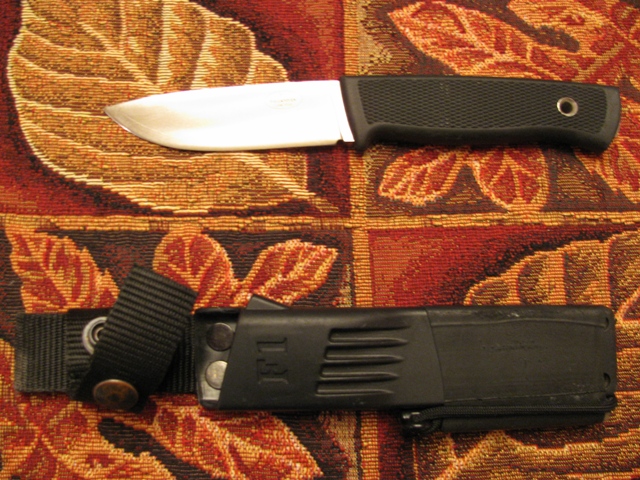
Fallkniven F1 with modified Zytel Sheath
Sharpening
The F1 is easy to sharpen. I use wet/dry sandpaper available from auto parts stores. I place the sandpaper over a thick mousepad and use it to sharpen the knife. This Website has very good sharpening videos that explain how to keep your F1’s convex blade sharp. In practice, the knife stays very sharp and I just keep it that way using a leather strop.
For a while, I adapted the same approach for keeping the knife sharp in the field. I cut a mousepad into a small strip and trimmed sandpaper to match. This solution is lightweight and convenient to carry. But the sandpaper is damaged easily in my pack and requires a flat surface to use effectively. So today I carry a Fallkniven DC-4 sharpening stone. It is a 1.25″x4″ dual-surface (ceramic/diamond) whetstone that stores in a small leather sleeve. Since the F1 has such great edge retention, I rarely use the DC-4 and carry it only on multi-day trips when I think I will use my F1 very often.
A Note About Counterfeits
Like Rolex watches, Fallknivens have a reputation for high quality, for which people are willing to pay. Recently, counterfeits have been hitting the market. Here is a link to Fallkniven’s page to help you recognize counterfeit F1s.
One dead giveaway is the lack of a lamination line. The F1’s blade is constructed from laminated stainless steel. The cutting edge is made from VG-10 steel. The hard (59 HRC) steel cutting edge is sandwiched between an outer layer of 420J2 stainless steel. The softer outer steel allows the blade to flex, giving users a hard steel cutting edge that is not brittle. This creates a lateral line just above the edge of the blade. The Chinese copies are made from a single (poorer quality) steel so they do not have this line.
Unfortunately, the line does not show well in my pictures, above. But it is obvious when you look at the knife in person, or in high quality photos. Below are two pictures that clearly show the lamination line. If you do not see the line, it may not be a Fallkniven F1.
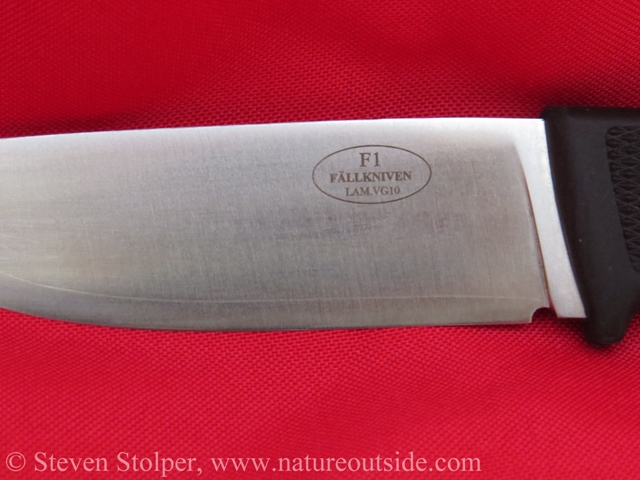
The lamination line is clearly visible running parallel to the edge
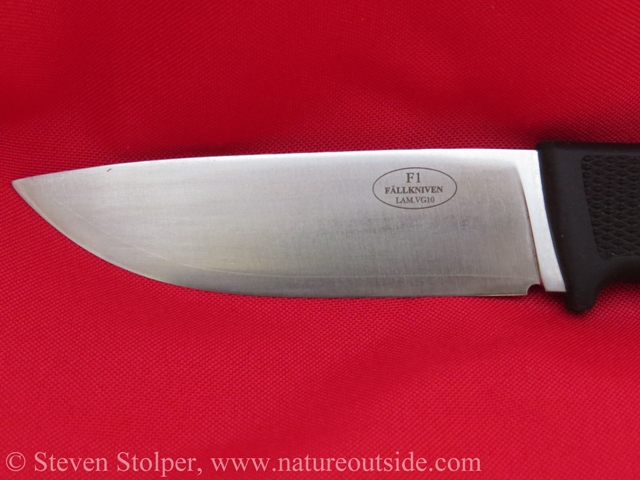
The lamination line runs the full length of the blade
I should point out that this technique of looking for the lamination line works only for recently manufactured knives. Fallkniven adopted laminated construction for the F1 sometime around 1998.
Addendum:
Since I first wrote this review, counterfeiters have become more sophisticated. NatureOutside reader, Dieu, points out in the comments below that some have learned to fake the lamination line. Visit Fallkniven’s website for the latest tips to spot fake Fallkniven knives.
Conclusion
I always grab my Fallkniven F1 when I head out to the woods. It seems like a natural extension of my arm. It is compact, but solidly built to tolerate abuse. It is easy to use and I have confidence that it won’t let me down.
Knives are tools. But they are also very individual. Several years ago I lusted after and purchased a different brand of knife that was much “prettier” than my F1. It is also a fine knife, but it remains locked in a drawer. For reasons hard to articulate, the F1 is “me”. So before buying, try to find a friend or a local shop that has an F1 you can examine.
I love my Falkniven F1. It is a quality, robust, forgiving knife that I am proud to carry. I hope you enjoy using yours as much as I do mine!
More Posts on NatureOutside
Bushcraft Knife Safety – 9 Tips to Avoid Accidents
Use Your Knife – Make a Whimmy Diddle Bushcraft Toy (Video)
How to Carve Swedish Spoons (Video)
For fun facts and useful tips, join the free Bushcraft Newsletter.

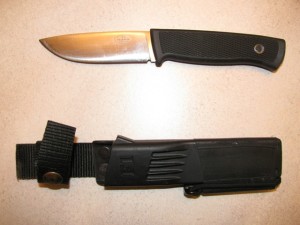
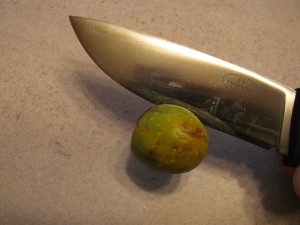


just bought a F1 still waiting for it to be delivered hoping to get a S1 some time in the future.Quaility knives. Have an enzo trapper as well so I have similar size knifes in carbon and stainless.Have a CSK going to get an SRk,S1 and Camper,Tops BOB and Benchmade 162.So just 4 to go will take a while but they should last a lifetime.These will be my high value blades but I also have several other knives like moras,prodigy,bg ultimate,shrade 3 to name a few as well as 2 kukris and other choppers
Congratulations on your new F1! It should serve you well for many years to come.
That is quite a list! Collecting knives and learning to use them well can be enjoyable and rewarding. You will discover that some knives lend themselves to certain tasks more than others. Your tastes may change as well. So be prepared! You may end up owning even more in the future.
Where did you purchase your knife? Where can I find one that I’m sure is authentic? I’m only asking because I don’t want to buy one online and then have to return it and incur shipping charges.
Walt D, there are several knife vendors I recommend. I have links to their websites in the “Resources” section of this site. I purchased two F1’s from Knifeworks.com and was happy with the price and service.
I hope this helps!
Hello Steve ,
on your page, some counterfeit might also have an etching line, making it harder to indentify from the Fallkniven website.
Laminate steel
All our knives are made in clad (laminate) steel, with no problem you are able to see the lamination line close to the edge.
Some illegal Chinese knife manufacturers – but not everyone – have tried to imitate that by etching such a line along the edge and that might be difficult for the inexperienced to understand.
Thank you for pointing this out, Dieu! I see from the Fallkniven website that illegal manufacturers have become more sophisticated. I will update this article to reflect the latest tips for spotting a fake.
The F1 and Dark timber 1911 Elite are the best blades I have ever owned.
Thanks for your comment, Randy! I’ve never tried a Dark Timber knife, but I will give them a look.